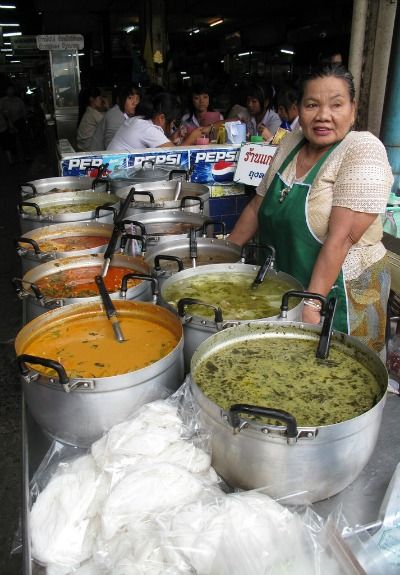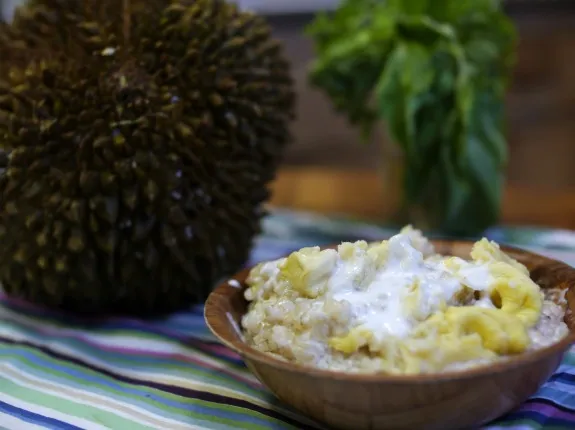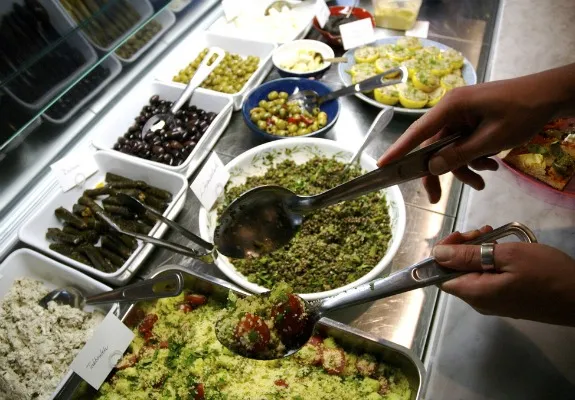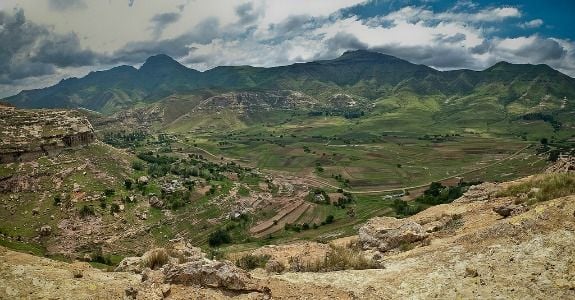Best Vegetarian Foods of the World
Traveling and eating abroad, many diners discover that the world is a vegetarian’s oyster
/https://tf-cmsv2-smithsonianmag-media.s3.amazonaws.com/filer/20120803122031VeggieTortillaSMALL.png)
“Vegetarians, and their Hezbollah-like splinter faction, the vegans, are a persistent irritant to any chef worth a damn. To me, life without veal stock, pork fat, sausage, organ meat, demi-glace, or even stinky cheese is a life not worth living. Vegetarians are the enemy of everything good and decent in the human spirit, and an affront to all I stand for, the pure enjoyment of food.”
I didn’t say that. Anthony Bourdain did. Actually, the TV chef thought it first, then wrote it, read it over a time or two, passed it by his editor and finally saw that it went to print in his 2000 hit memoir Kitchen Confidential. Even today, Bourdain is known for trash-talking vegetarians. He seems to hate them, really, with an enraged, pit-bull-on-a-rope passion. Their selective eating patterns offend Bourdain, who proudly devours anything that another person tells him might be food. Meanwhile, he has called vegans “self-indulgent,” and in his 2001 eat-your-way-around-the-world chef’s adventure story, A Cook’s Tour, he flaunts a bean-brained idea in Chapter 13 that First World vegetarians are somehow, to some degree, to blame for the misfortunes of hungry people in developing nations. Isn’t it just bizarre how a group of people that elects not to participate in the killing of animals can incite such boiling antipathy?
Anyway, last time I discussed some of the impacts that raising livestock incurs on the planet. This time, I suggest a few things to eat abroad, where many diners discover that the world is a vegetarian’s oyster.
Mexico. Corn tortillas, beans, avocado and salsa. It’s the bread and butter of Mexico and perhaps the most common table staple in Central America—yet there’s not much that beats a hot-off-the-skillet handmade corn tortilla, especially when stuffed with basic vegetarian taco fillings. Such tacos were a staple for me about a decade ago, when I spent many months trudging around the deserts of Baja California. Often, as I hiked across the sunburned wilderness, I caught a whiff on the wind of cooking tortillas—that toasty, warm scent of carbohydrates turning brown on a cast-iron pan. The telltale smell of a ranch! Following my nose, I would soon hear the pat pat pat of tortillas being made by hand (as well as the jingling of goat bells). I was a cheese-eater without relent in those days, but often I would buy 30 corn tortillas and for dinner have tacos filled only with avocados, tomatoes and lime. But travelers, watch out for lard; though corn tortilla dough usually consists only of masa, water and salt, some tortillas are cooked on skillets rubbed with swine fat. If you make them at home, rub the pan with a fleck of coconut oil before cooking each tortilla.

India. Chana masala. The great garbanzo bean (a.k.a. chickpea) stars in this classic dish of India, home to about 400 million vegetarians. Chana masala is simply protein-packed garbanzos stewed with onions, tomatoes and a curry of spices, including coriander, cumin and turmeric—and is often served over rice or eaten with naan (beware of buffalo butter, called ghee, or, heck—just enjoy it). Garnished with cilantro, mint or green onion, chana masala, though almost always a staple of cheaper Indian restaurants, can be as elegant and satisfying as any celebrated dish of Mediterranean Europe.
Thailand. Coconut curry. For many travelers, Thailand means bamboo beach huts, elephant rides in the jungle and snorkeling in water as clear as air, while for those of the epicurean persuasion, Thailand is just about synonymous with thick and creamy coconut curries. These are often based on animal broths or spicy shrimp pastes, and are often served with meat. If you want vegetarian options and can’t find any at the street stalls, make your own back at the palapa. You’ll need a pot, a fire beneath it, vegetable broth, coconut milk, palm sugar, lemongrass and curry spices. Beyond that, the curry crock is your playground. Try stewing sweet potatoes, taro root and plantains. And for dessert, step over the border to Laos and try a scoop of khao niao durian, the flesh of the famously pungent fruit smashed into a helping of sticky rice with coconut milk.

Italy. White Bean Peasant Soup. They wrap their figs in bacon, they stuff their truffles into veal slabs and they grate cheese over nearly every main plate—and Italy is hardly a vegan’s paradise. But white bean peasant soup, or ribollita, was traditionally a vegetarian dish, and often without even cheese. Chef Mario Batali explains here that the poor of old Italy often had no meat to cook and, when fortunate enough to have leftovers (or unfortunate enough to have only scraps and crusts), they sometimes combined all in a stewing pot. With white beans, the dish provided protein and carbohydrates in one hit. For those trying this dish at home, add some dried porcini mushrooms and red wine to the broth for a heartier kick. Or follow this recipe, which leans to the lighter side, and includes sautéed apples. As Batali says, “You can’t mess up ribollita.”
Chile. Porotos Granados. Built of New World ingredients, porotos granados is a stew of pumpkin, cranberry beans, corn, onion, spices and broth. The final consistency is much like porridge, with the squash mashed into a purée. Flavor can be enhanced by roasting the corn over a flame first, and caramelizing the onions in the pot before adding the broth also enriches the dish. Kabocha squash can be substituted for the pumpkin, and a light sweetness can be added with mashed overripe plantains.
Lebanon. Tabouleh. It’s made of bulgur, onions, parsley, mint, tomatoes and cucumber, with a dressing of olive oil and lemon juice. Light but substantial, tabouleh, eaten cold, is refreshing on a hot evening and an easy last-minute make for a bring-along party dish. Home cooks might even take the Middle Eastern theme a step further and add diced dried and toasted walnuts. Served with hummus, olives and falafels, tabouleh completes a classic vegan feast of the Middle East.

Eritrea. Injera and Wat. One of the most memorable parts of any Eritrean or Ethiopian meal is the simplest—the injera, or sour, spongy flatbread. Injera is made with the flour of teff, an indigenous mountain grain, and wheat or barley. Mixed with water, it is left to ferment for several days until the batter smells like buttermilk. The bubbling batter is ladled onto a skillet and cooked like a pancake. On the table, the injera serves as a utensil, a sponge and a napkin, and the meal is officially over when the sheets of injera spread over the table have been eaten. Injera is typically eaten with soups, such as wat, a dense and spicy lentil stew.
Greece. Dolmas. I was devastated in 2006 after traveling from Italy to Greece by ferry and discovering, after several visits to produce markets, that hummus simply didn’t exist in this land. After 30 hours aboard the boat, I had been anticipating a meal of hummus and dolma grape leaf wraps. Turns out, hummus is strictly Middle Eastern. However, my expectations of the illustrious dolma, or dolmade, were met—for rice seasoned with olive oil and spices and wrapped in grape leaves is the ubiquitous bread-and-butter comfort food of Greece. Like so many vegetarian staples, dolmas are as delicious and satisfying as they are simple. They can be bought nearly anywhere for a trifle, or they can be made at home—and whether you’re camped alone in the woods after a long day of journeying, or hosting friends for a potluck, a plate of dolmas meets the mark.
Lesotho. Moroko. OK—so this dish may underwhelm, but when I asked a friend what vegetarian dishes she enjoyed while traveling recently in Lesotho, that little landlocked island of sovereignty within South Africa, she immediately said, “Moroko.” So simple and nondescript that I’m surprised it even has a name, moroko is just greens roughly chopped, simmered with some oil and broth and mashed into a soggy green porridge. Should you visit Lesotho, take a drive, inhale the astonishing mountain views, then gather wild greens along the roadsides to stew later for dinner. Vegetables like kale, spinach, chard, dandelions, mustard and radish can all be used in moroko. The dish is often eaten with rice or potatoes.

A few famous vegetarians:
Chris Martin, lead singer of Coldplay.
Brad Pitt, actor.
Paul McCartney, musician.
Gandhi, pacifist and social revolutionary.
Larry Mullen Jr., drummer of U2.
Plato, Pythagoras, Aristotle, Plutarch and Socrates, scholars of ancient Greece.
A few famous vegans:
Thom Yorke, lead singer of Radiohead.
Kevin Nealon, comedian and former Saturday Night Live cast member.
Tobey Maguire, actor.
Mike Tyson, boxer (recently converted, Tyson chomped Holyfield’s earlobe ages ago).
Chrissie Hynde, lead singer of The Pretenders.
Scott Jurek, long-distance runner. I spoke with Jurek recently by telephone. One of the world’s most acclaimed long-distance runners, Jurek was the featured superstar in the 2009 book Born to Run. He has been a vegan since 1999 and names quinoa, brown rice, beans, hummus and burritos as a few of his favorite plant kingdom staples. Jurek partly credits the very absence of animal protein in his diet as a source of his health, athletic dominance and collection of world records—including the world’s fastest time on a 165-mile run.
Are you a vegetarian or a vegan? Have environmental factors played a role in your decision?
And what foods did I miss from this list?
/https://tf-cmsv2-smithsonianmag-media.s3.amazonaws.com/accounts/headshot/Off-Road-alastair-bland-240.jpg)
/https://tf-cmsv2-smithsonianmag-media.s3.amazonaws.com/accounts/headshot/Off-Road-alastair-bland-240.jpg)